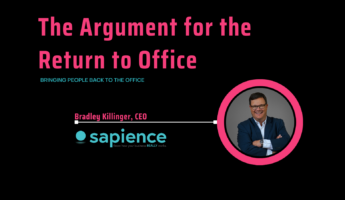Sapience Analytics
Workplace Productivity is the New Measurement of a Successful Business. Here’s Why.

Want to learn more about this? Subscribe below and one of our specialists will get in touch with you with more info!
Due to the recent explosion in remote workforces combined with the need for business models to be fast, precise and accurate, tracking workplace productivity is emerging as the key metric. It’s seen as the most meaningful way to determine if your business is lagging behind or truly achieving success within the current shifting business landscape. Let’s take a closer look at why you should consider workplace productivity measurement.
Eight Ways Workplace Productivity Impacts Your Success
Before we get into measurement, let’s quickly review what productivity is and why it’s important to the success of your business.
In the workplace model, productivity is a measure of the efficiency of your individual employees and teams in converting efforts into desired outputs. The most basic method of calculating productivity is to divide the average output per time period by the costs incurred or resources used in that same period.
The most obvious reason why workplace productivity is important is perhaps the most simplistic: Your workers are a resource you invest in, and the general idea of business is to get the highest return on investment as is ethically possible. Here are implications of that ROI:
- When you understand the productivity of any team or individual as a unit, you can also determine whether that unit is performing at an optimal level. “Optimal” is usually considered to be that sweet spot between underperforming and being overburdened with too many tasks. Once this sweet spot is quantified for any unit, you can make any necessary changes in work load or work flow to optimize that unit. Output increases without increasing your investment.
- Similarly, once productivity is benchmarked, monitoring it over time allows you to spot and address any decreases as they arise.
- Knowing your productivity levels allows you to determine if your operations can take on additional responsibilities – in other words, expand your business. Or, if business is already expanding, understanding productivity helps predict what resources must added to handle it.
- Your business should use productivity as a measure of whether your operations are effective, which allows you to make important investment decisions that affect the future of your business.
- Measuring workforce productivity uncovers your top performers (as well as those who would benefit from extra training). Knowing your top performers within teams allows you to build profiles that inform recruitment activities.
- Finally, establishing workforce productivity also encourages the establishment of employee and team goals, as well as recognition of achievement of those goals. Educating employees about their own productivity encourages their motivation; establishing objective standards against which they’re measured, and providing ways to help them meet those standards, increases job satisfaction.
- All these points lead to a company culture that values the individual employee as well as overall value and quality. And that’s a culture that supports employee retention.
Getting the Most Useful Workforce Productivity Measurements
In our manufacturing past, productivity was measured by simply counting widgets and doing time-clock calculations as described above. With the white-collar office came timesheets and spreadsheets. With the evolution to “knowledge workers,” our monitoring tools have become more sophisticated. Here’s a quick summary.
Time Measurement
Today’s time monitoring method involves tracking how every employee spends their work time – usually by manually entering the time spent on each task into a worksheet or spreadsheet. While this method does help ensure time is not being wasted, the bigger an enterprise or team gets, the harder it can be to accurately track and analyze the time of any one employee. This problem is compounded by remote working and also can be too simplistic to apply to the intangible tasks of knowledge workers.
Output Monitoring
It makes more sense for many businesses to measure workforce productivity based on output instead of time. For complicated projects, the output may be broken down into the completion of incremental tasks. Project management tools also calculate employee productivity on each project, noting time spent on each task.
There are a few problems with this approach, however:
- While driven by basic data, it tends to look at only one or two aspects of productivity rather than the 360-degree view.
- It can’t collect the details that suggest ways to optimize employees’ processes or communication.
This brings us to the gold standard of measuring productivity in today’s technology-driven workplace.
Comprehensive workforce productivity monitoring
As we’ve seen, productivity can no longer be determined by simply counting or filling out forms. The best measurements must keep an eye on outcomes while still objectively monitoring all aspects of employee and team work activity. For instance, how much time does an individual spend dealing with email or going to meetings? What ratio of their time is spent on work activities that aren’t essential to their primary job responsibilities? Does their behavior indicate they’re overburdened, or having to adjust their activities to make up for a process bottleneck elsewhere?
Comprehensive monitoring solutions track every aspect of the employee workday from the moment they log on, unobtrusively and through any work device. No one has to spend time on manual entry; managers aren’t forced to parse through worksheets. Instead, dashboards display activity and outcomes in near real time, for teams. Importantly, the reports are completely data-driven, which makes it easier to see patterns, set objective goals and priorities, and quickly determine progress toward success metrics.
When this data is readily available, the dynamic between manager and employee becomes more constructive. Instead of focusing on concepts of time and concrete output, both manager and employee can focus on the process of deciding collaboratively what real productivity looks like. Employees can also see their dashboard and will know immediately if they’re on track to hit the goals they’ve helped set; if they get off track, it’s easier to see why and how. Consistent accountability leads to more trust; motivation leads to more recognition, which improves employee engagement and retention. And a self-reinforcing workplace productivity loop is reinforced.
When your company is ready to take workplace productivity to the next level and reap benefits like these, Sapience is an industry leader. We have decades of experience and clients around the world whose results have included increasing work output by up to 40%, increasing time spent on core work by up to 30%, and strengthening correlations between effort and output by as much as 64%. Contact us today to learn more.
We want to tell your more! Subscribe below and one of our specialists will get in touch with you with more info!
Similar Blog Posts

Make Confident
Business Decisions
Sign up for a free Vue™ demo. Learn how to identify hidden insights in your workforce data to drive productivity.

Request a Demo
Sign up for a free demo. Learn how to identify hidden insights in your workforce data to drive productivity.










